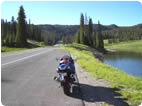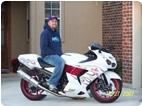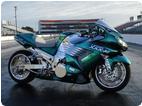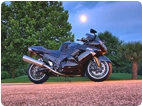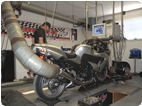The lower the rpm, the more the vac exposes itself, the more you can chase a smoother pulse.
There are 4 holes in the throttle bodies:
1. Right behind the main plate is a hole that leads to the air screw. Once the air screw is open for the closed throttle side...
2... This second air hole can now add more air to the closed throttle. Aerodynamics play a big part in air flow. So we are now in the middle of that second air out on the [in valve] side of the throttle plate. Here is the argument sake I point out 3 variables to smoothing out the balance.
a. You're, 'I'm going to count out so many turns of the air screw' is where you land is not exactly at the other screw hole. So this is just a guess, you really need to see the aero happening thru sync.
b. If I were to tap the hole for the needle, my t-handle would be at say the 3-9 o'clock angle is tap this hole here. If I began the tap at the 12-6 o'clock position, I turn so many turns out, look at my thread to position now? By that starting point in the body to make a thread; is this variable of so many turns out.
c. My gas [reversion-for every action] is going to etch the brass needle and air is going to go around; that once tapered V. So I now change the needles via inspect or as per book.
d. Say I closed the needle too hard and caused a compression-line around it. That is a moving air molecule(s) rushing past and upsetting the aero.
3. This next hole or the one with the hose nipple is this one is attached to all the others. Why? Each cylinder is in a timed sequence, where one intake is opened at a time. You now can monitor each vacuum pulse at the IAP sensor. When the next engine cylinder takes in a gulp of air, this is monitored via the vac at that hole. So you know all those attached hoses land into the one hose off the IAP. I stall, I look here for hoses off, cut, cracked, kinked.
4. This last hole is for the sync tool. This has a little hose or a stopper plug over the nipple. Here is where you attach the vac gauge or manometer hoses onto the throttle body. 1-2-4-3 is the firing order, so if you are going to use all 4 nipples for the sync, look how close the matching pulse is, you use 2-4 to sync the throttle plates first.
Now for some options:
1-4 hookup; I can close the needles from the outside is to sync 1-4 and the pulse is so fast, we are nitpicking how a pulse is about even by the time the naked eye sees it. If this is how yo want to run the 2-step sync is one way.
2-4 hookup is the other way to sync the shafts first. Of course this is going to be more low speed screw adjusting, but this is the process via the shop manual, but I look at it another way.
1-2-3-4 hookup; Here is where the book says not to mess with the middle screw, you did not rebuild the body, take it apart, upset the blade balance. So the book says to sync the screws instead... Now, think about this...
Closed low screws - I have to raise the idle = I lost a little air.
Speed Event = The air is closed so at the blade this says; whoever rushes the door first ~ Turns Rich.
The needles being a 1/4 open across the board - I now sync the air screws to see where they are at? Ready? I don't care about balance of merc in the mano or needle at the gauge. When I turn in or out, out is LEAN; so do I turn the others out and there goes the drop/climb? Yes. That says; Remember how that one screw responds so I know if I want to run rich or lean in the smoothing = Richer means smoother. Lean means = Mean.
